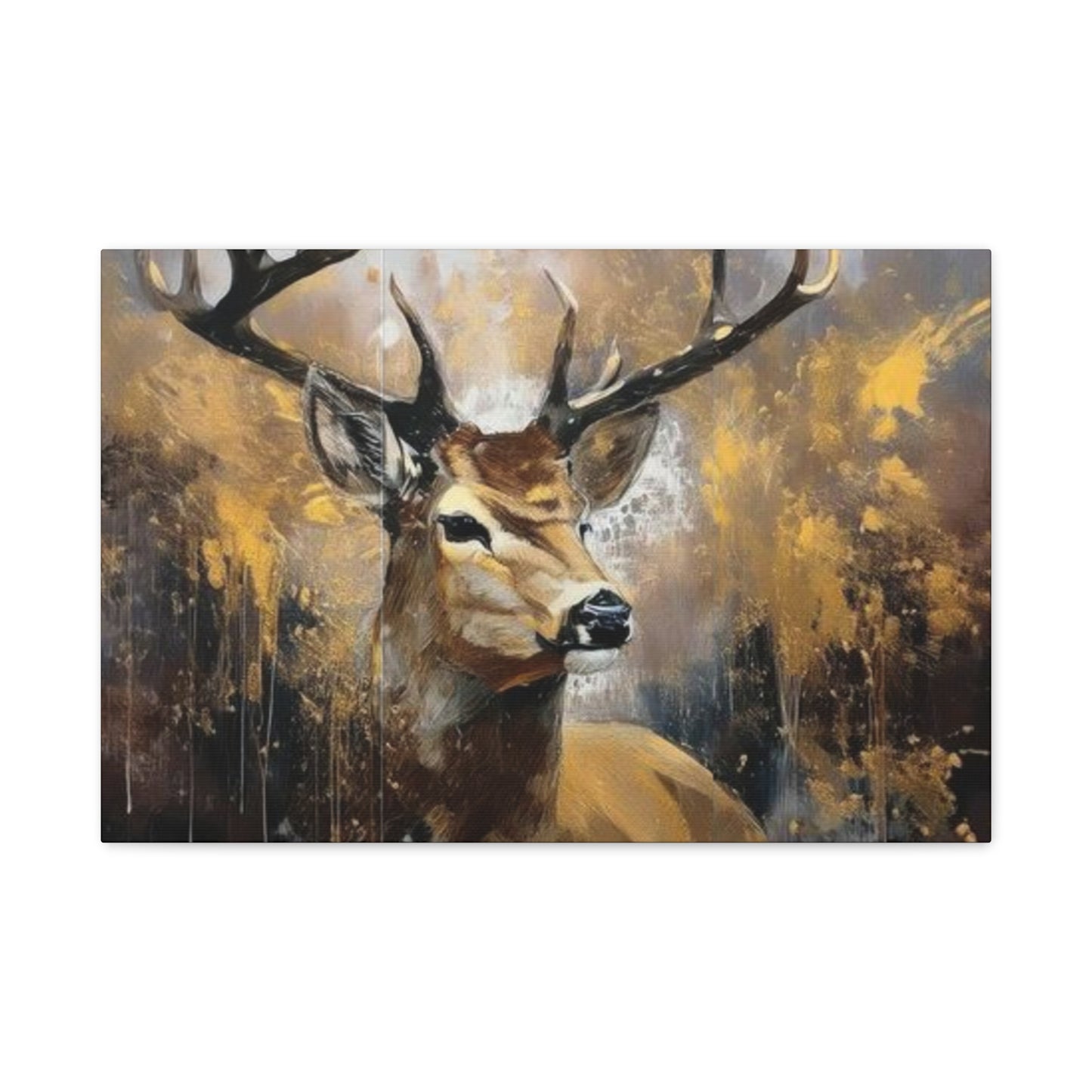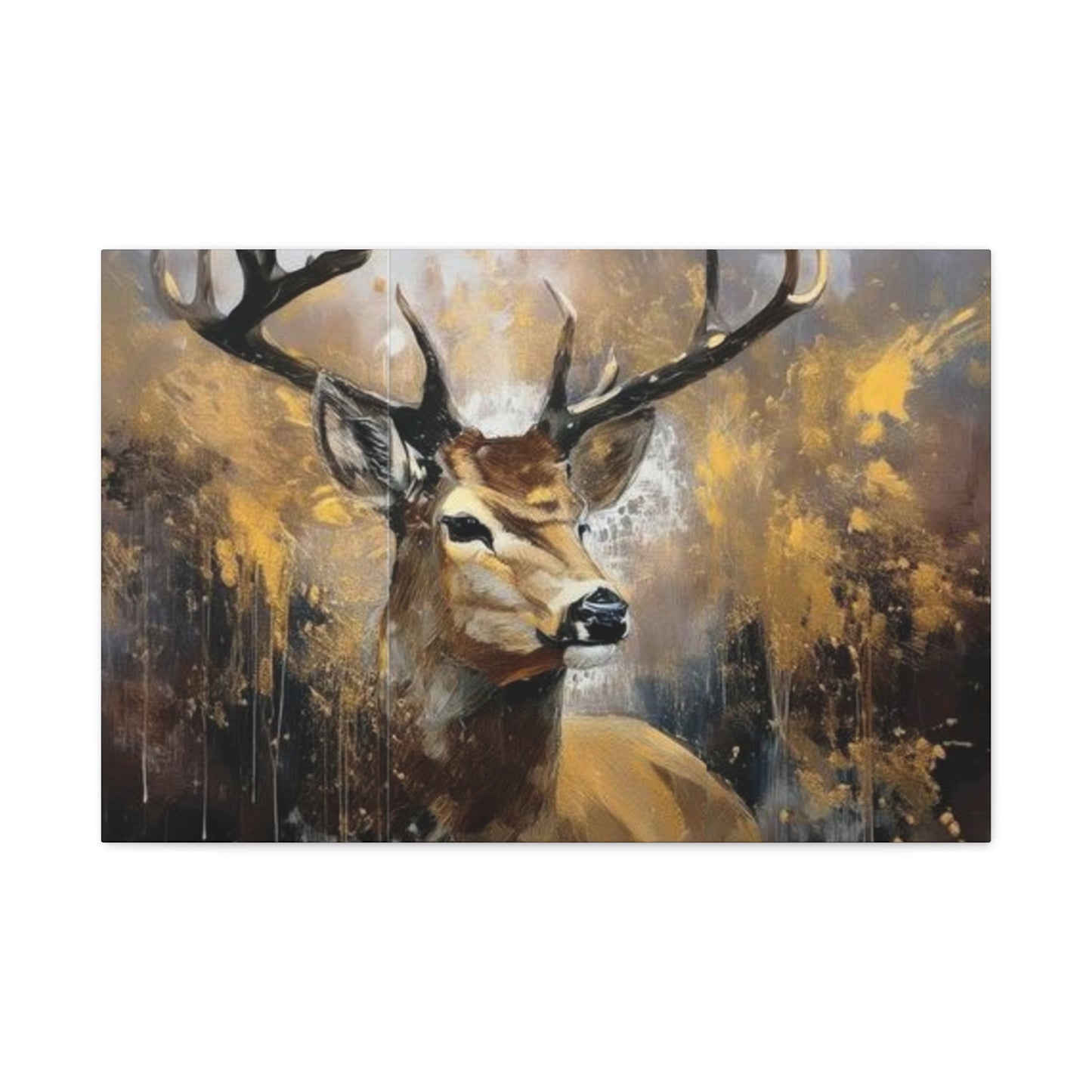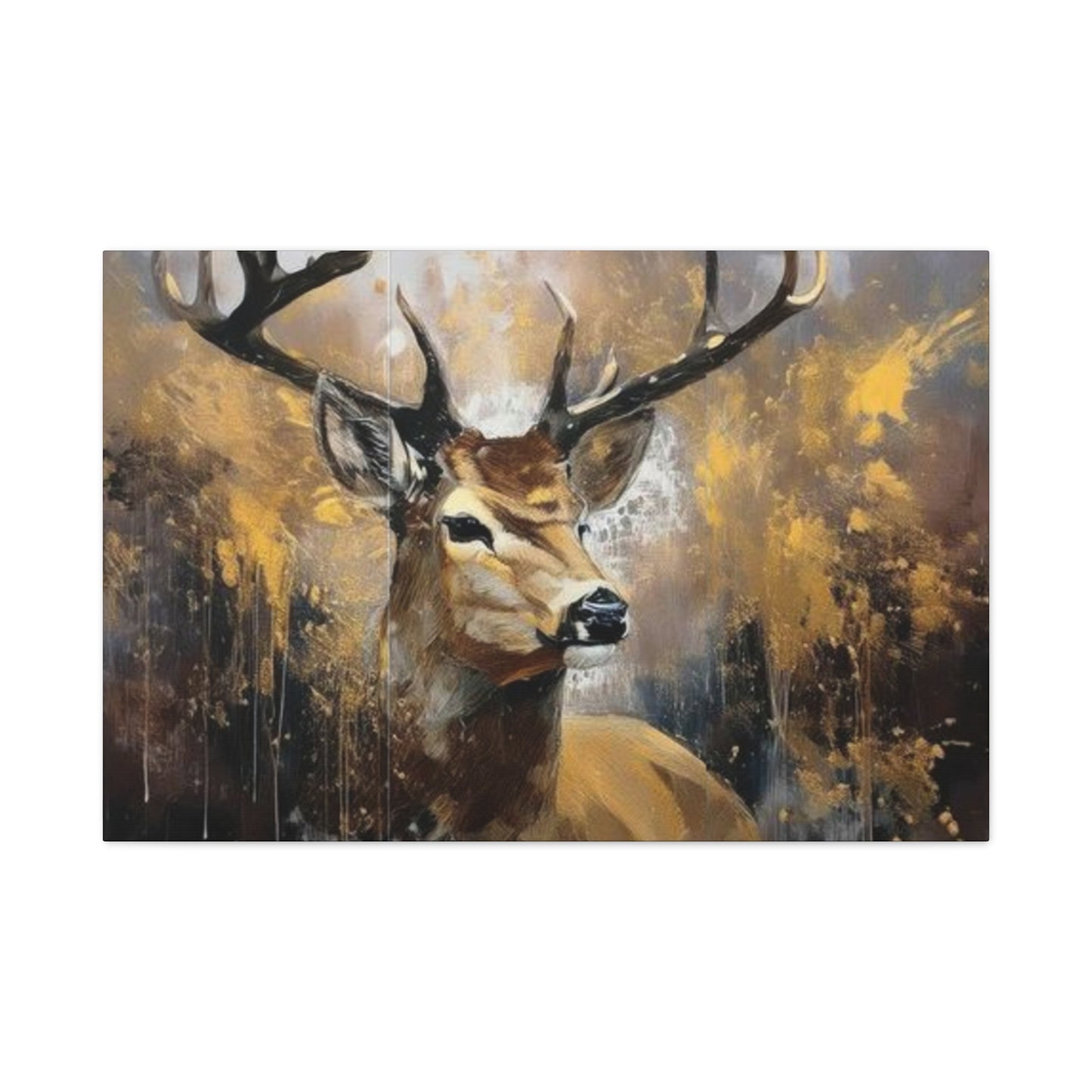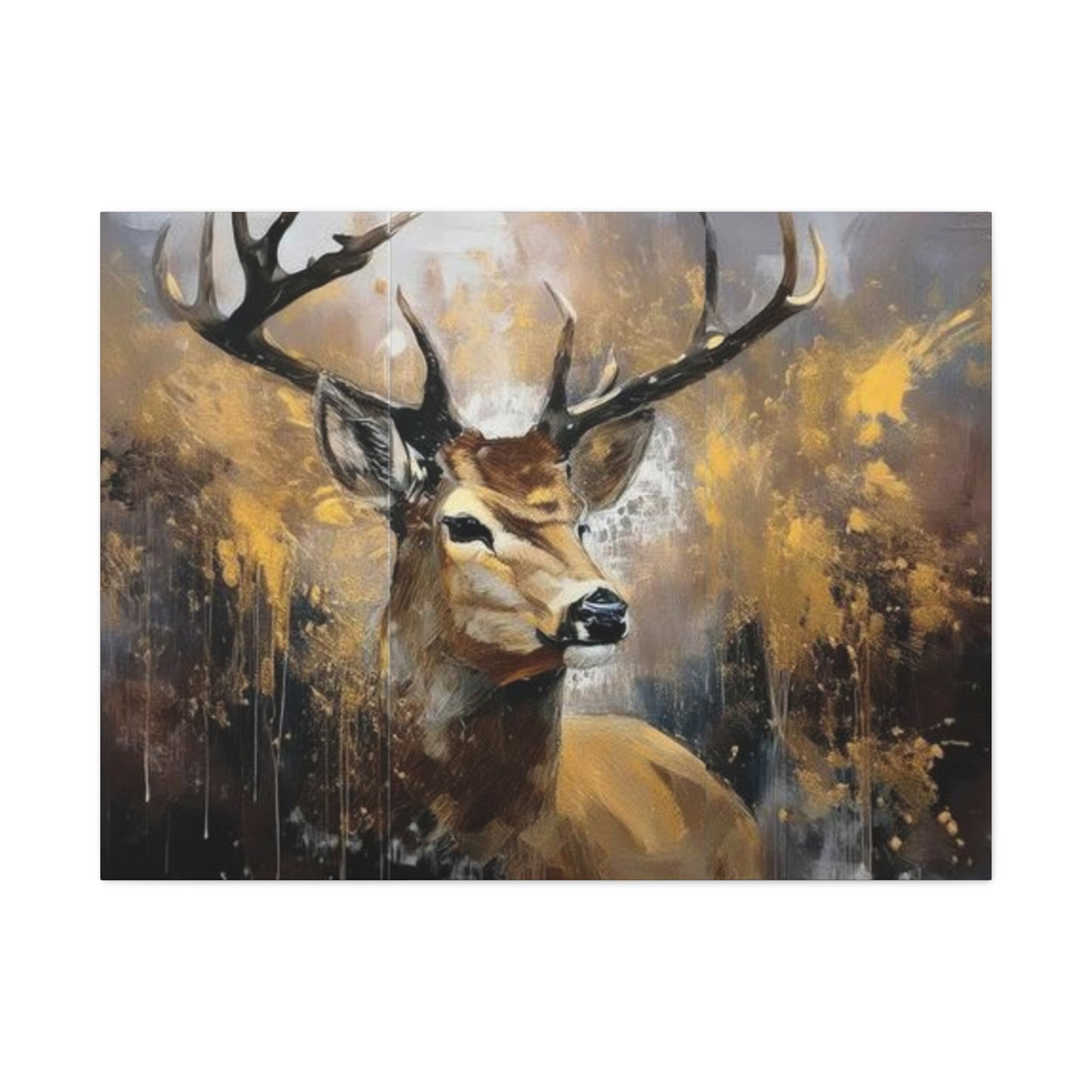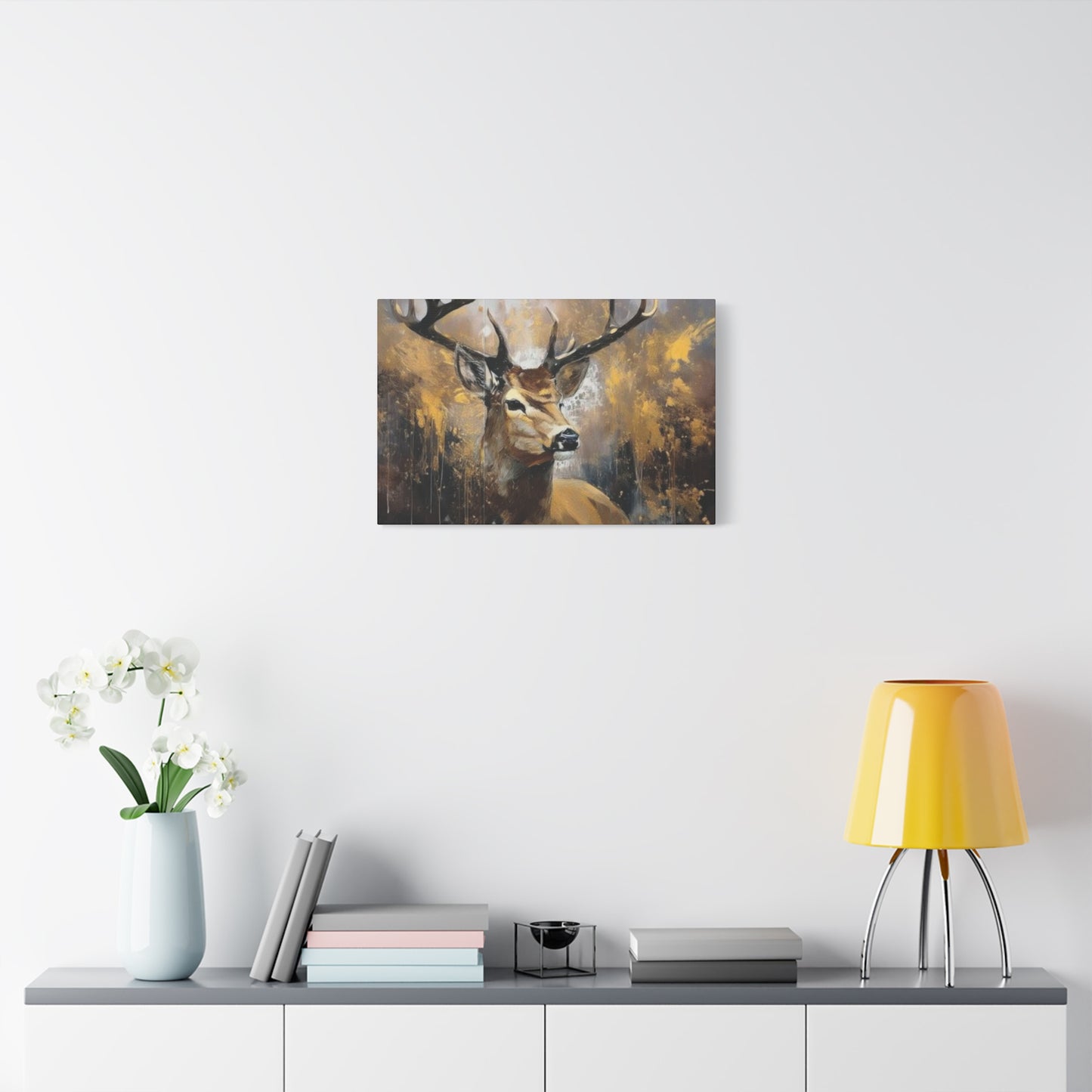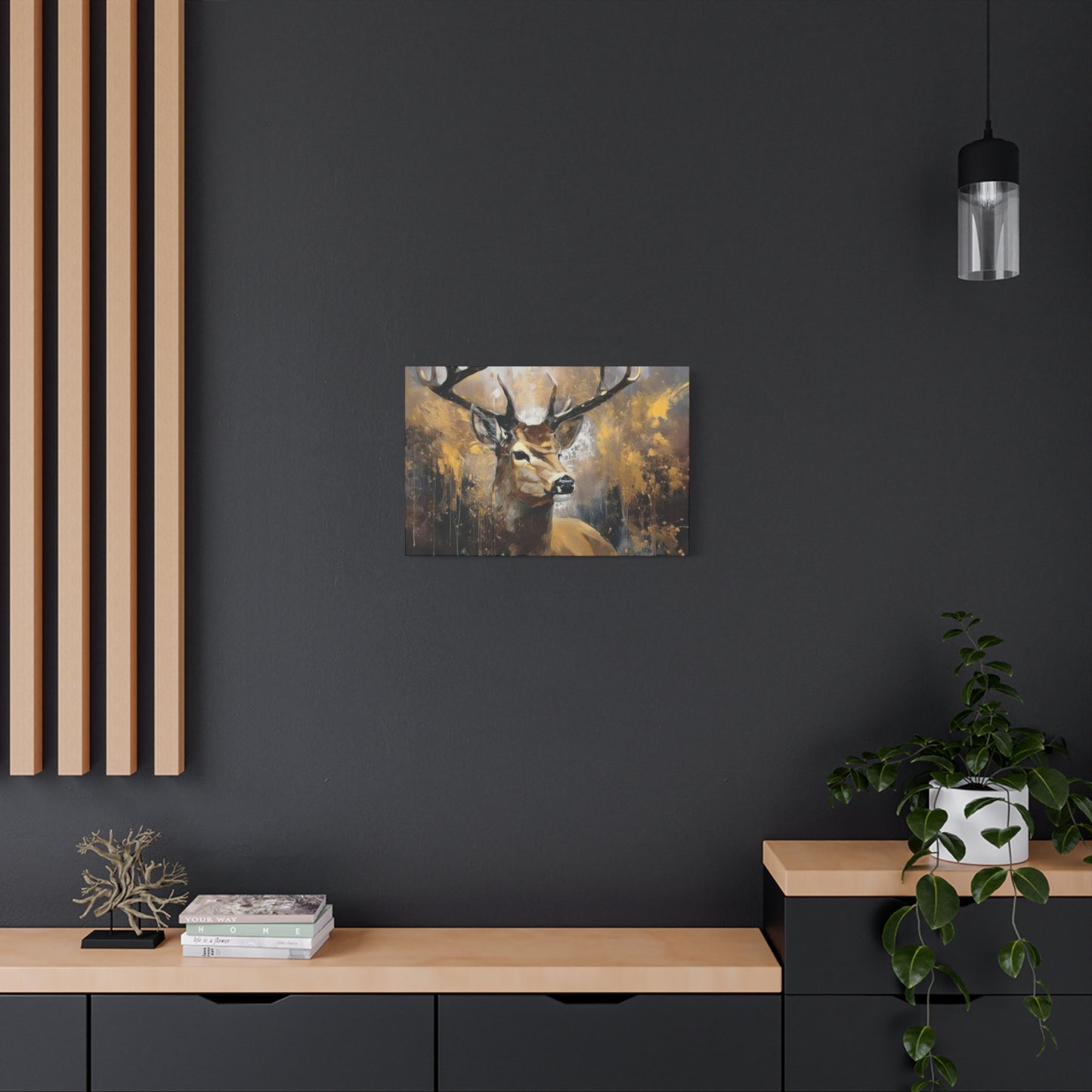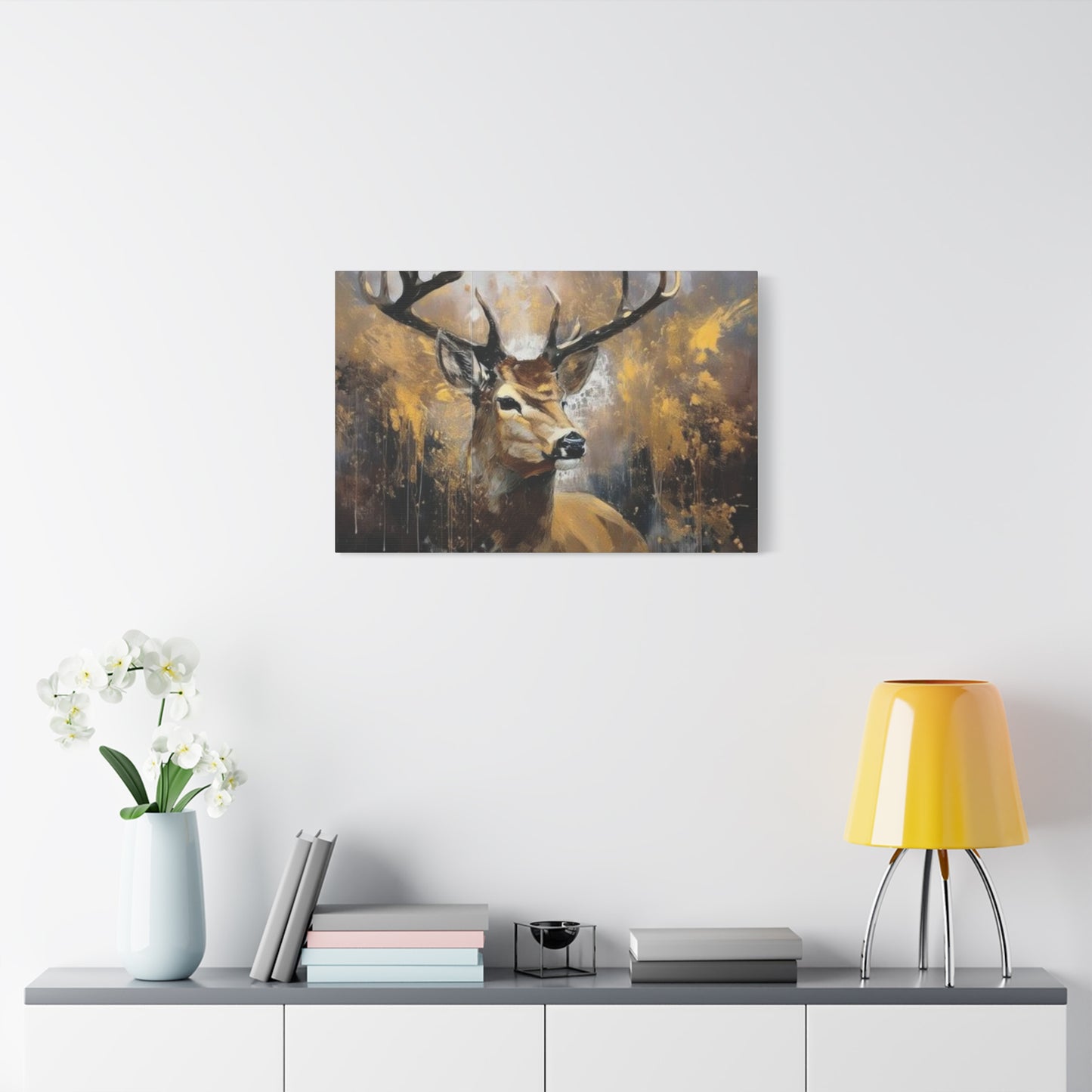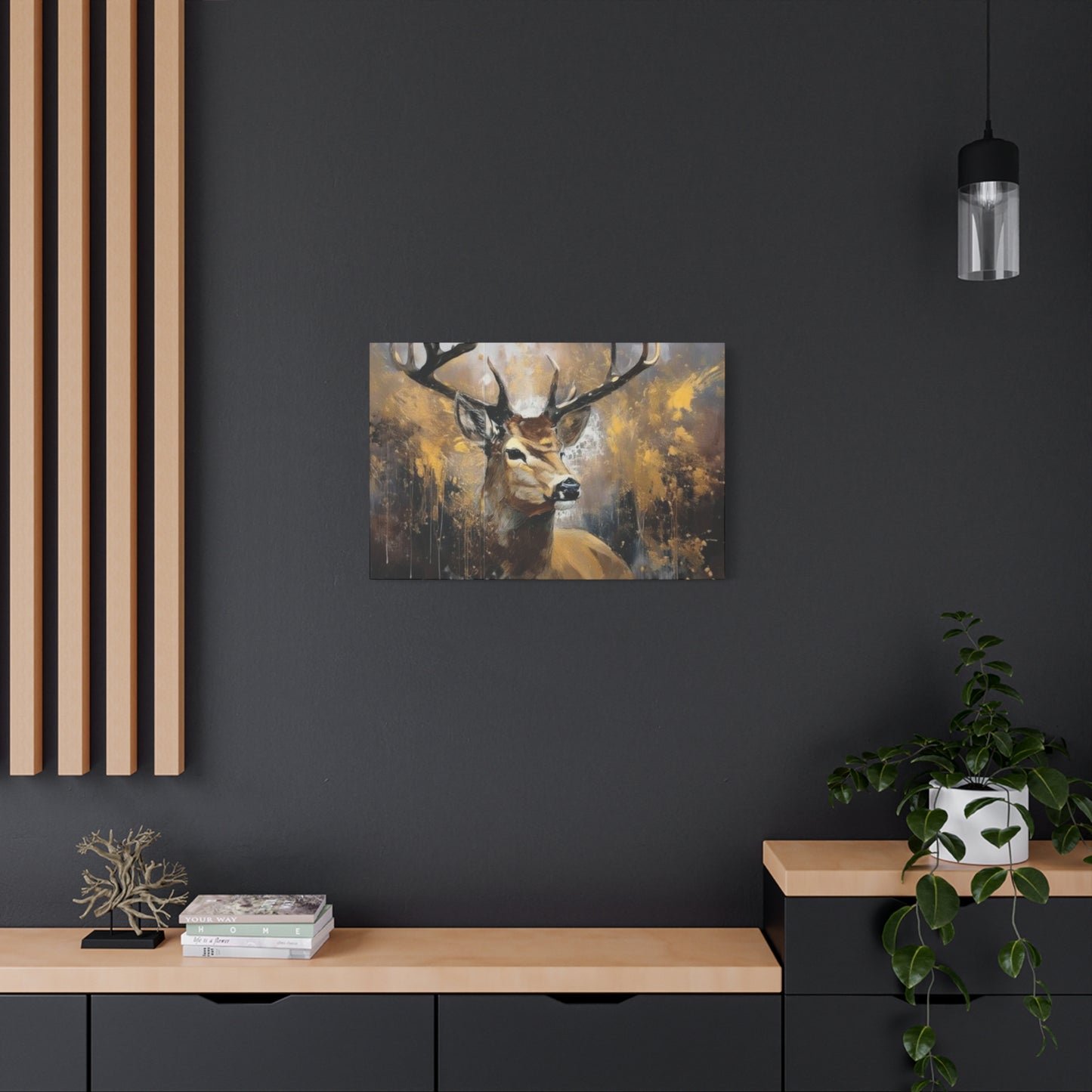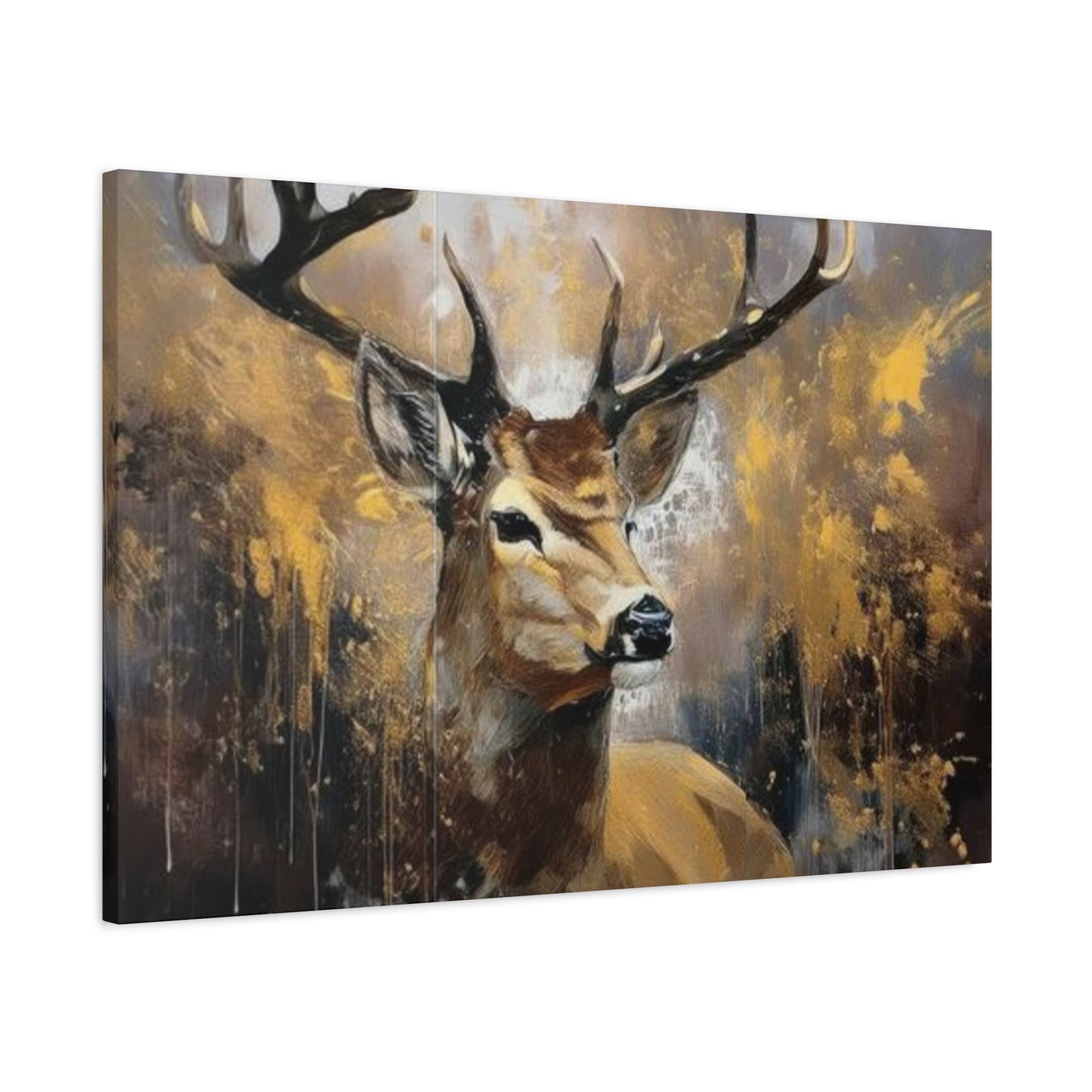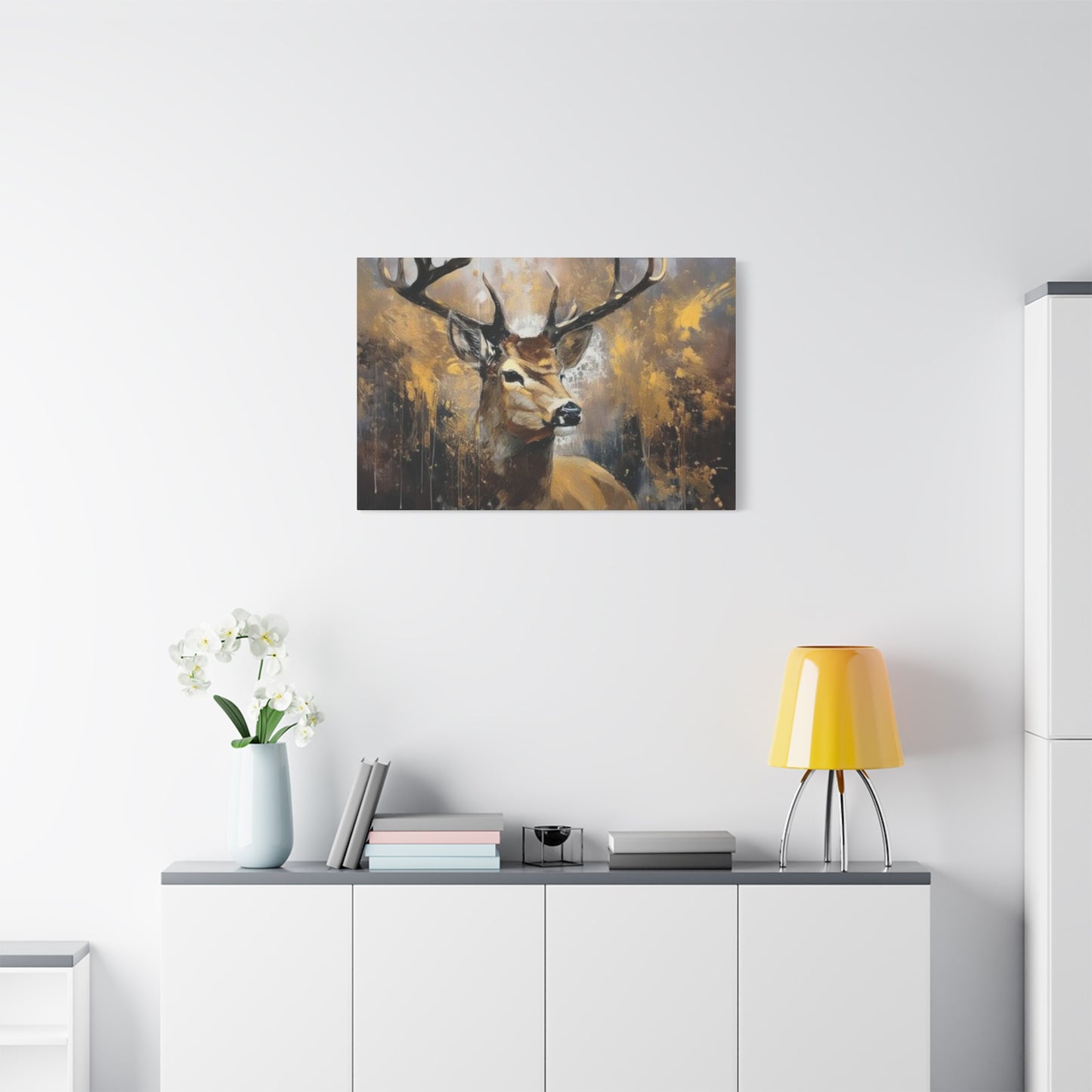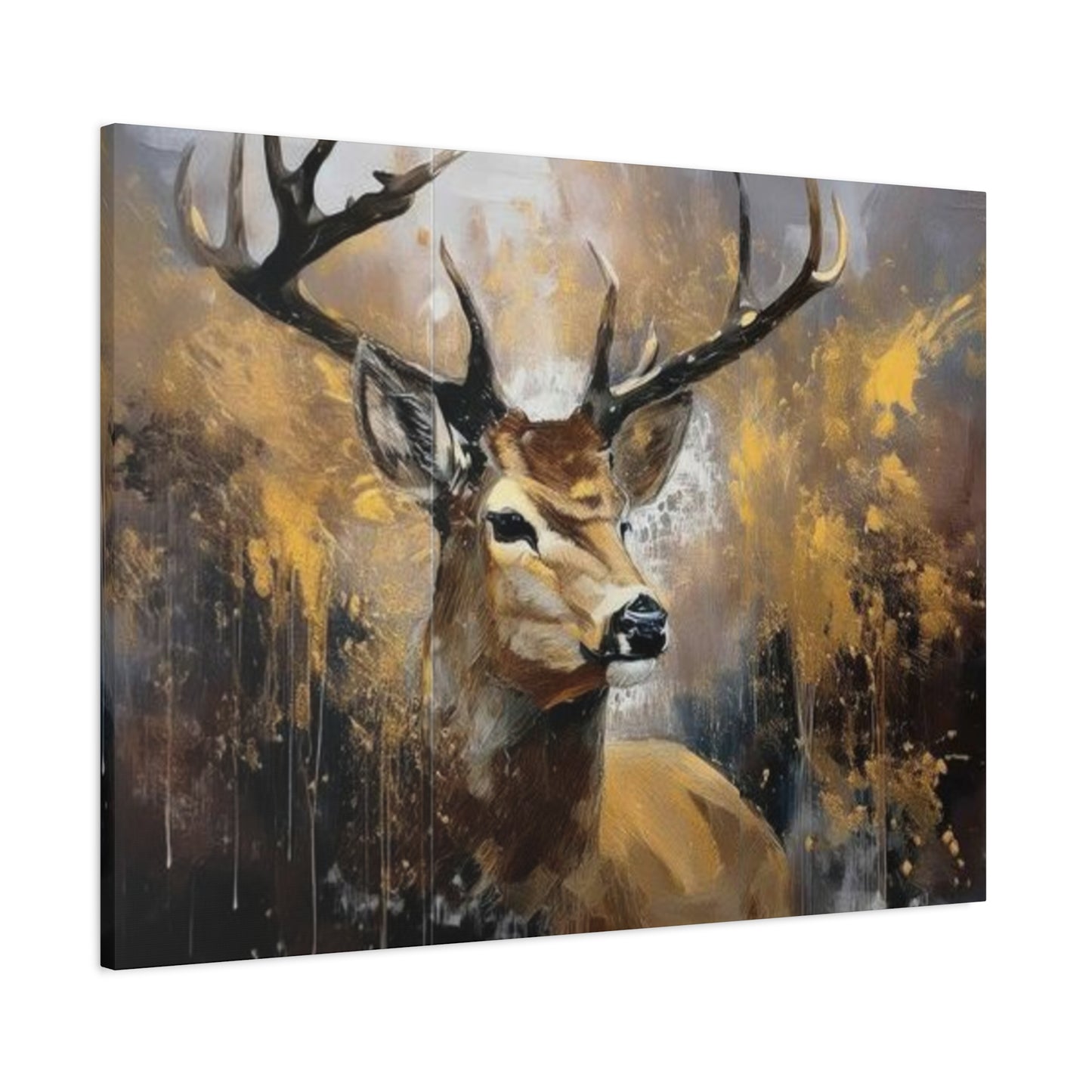Festive Forest Glow: Golden Reindeer Wall Art for a Charming Holiday
The world of interior design has witnessed a remarkable transformation in recent years, with wildlife-inspired artwork taking center stage in contemporary home decoration. Among the most captivating and sought-after pieces are those featuring majestic reindeer adorned with golden accents, printed on high-quality canvas materials. These stunning visual masterpieces combine the raw beauty of nature with the luxurious appeal of metallic finishes, creating artwork that transcends traditional boundaries and speaks to the soul of anyone who appreciates both wilderness and elegance.
When we examine the growing popularity of these artistic creations, it becomes evident that they represent more than just decorative elements. They embody a connection to nature, a celebration of wildlife, and an appreciation for craftsmanship that elevates any interior space. The golden elements incorporated into these pieces add a dimension of sophistication and warmth, making them suitable for various design aesthetics ranging from rustic cabins to modern urban apartments.
The reindeer, as a subject matter, carries profound symbolic meaning across different cultures and traditions. These magnificent creatures represent endurance, grace, and the untamed spirit of northern wilderness. When artists capture their essence and combine it with golden hues, they create visual narratives that resonate with viewers on multiple levels. The shimmering gold accents catch and reflect light in mesmerizing ways, bringing dynamic energy to static walls and creating focal points that draw the eye and spark conversation.
The Artistic Significance of Wildlife Imagery in Modern Home Decoration
Contemporary interior design philosophy has moved away from purely minimalist approaches toward more expressive and meaningful decoration choices. Homeowners and designers alike are recognizing the emotional and aesthetic value of incorporating nature-inspired artwork into living spaces. Wildlife imagery, particularly when rendered with artistic flair and enhanced with luxurious elements like gold leaf or metallic paints, serves as a bridge between the natural world and our domestic environments.
The presence of animal subjects in artwork has deep roots in human history, dating back to prehistoric cave paintings. This enduring fascination with depicting wildlife reflects our innate connection to the natural world and our desire to bring elements of that world into our personal spaces. In modern contexts, these artistic representations serve multiple purposes: they remind us of environments beyond urban settings, they celebrate biodiversity, and they introduce organic forms and textures into spaces that might otherwise feel sterile or disconnected from nature.
Reindeer-themed artwork holds particular appeal because these animals embody characteristics that many people find inspiring. Their ability to thrive in harsh climates demonstrates resilience, while their graceful movements and distinctive antlers present aesthetically pleasing forms that translate beautifully into visual art. The addition of golden elements elevates these depictions from simple wildlife portraits to sophisticated art pieces that can anchor entire room designs.
Exploring Different Artistic Styles for Deer-Themed Canvas Artwork
The versatility of reindeer subjects allows artists to interpret them through countless stylistic lenses, each offering unique visual experiences and emotional resonances. Understanding these different approaches helps collectors and decorators select pieces that align with their personal aesthetic preferences and complement their existing interior design schemes.
Realistic renderings capture every detail of these magnificent animals with photographic precision. These pieces showcase the intricate texture of fur, the liquid depth of eyes, and the complex branching patterns of antlers. When combined with golden accents, realistic styles often incorporate the metallic elements subtly, perhaps as highlights on antler tips or as atmospheric background effects that suggest magical winter light. These works appeal to nature enthusiasts who appreciate biological accuracy while still desiring artistic enhancement.
Impressionistic interpretations take a different approach, focusing on capturing the essence and emotional impact of the subject rather than precise anatomical details. These pieces might use loose brushstrokes and abstract golden elements to create atmospheric compositions that evoke feelings rather than depicting literal scenes. The golden components in impressionistic works often appear as fluid, dreamlike elements that blend with the reindeer forms, creating cohesive compositions that feel both grounded and ethereal.
Contemporary abstract styles push creative boundaries even further, deconstructing reindeer forms into geometric shapes, bold color blocks, and striking golden accents that create modern masterpieces. These pieces appeal to collectors with avant-garde tastes who appreciate how traditional wildlife subjects can be reimagined through contemporary artistic languages. The golden elements in abstract interpretations might appear as sharp metallic lines, textured patches, or as entire background fields that provide contrast to darker animal silhouettes.
Incorporating Metallic Elements into Wildlife Artwork for Maximum Visual Impact
The integration of golden components into wildlife imagery represents a sophisticated artistic choice that elevates decorative pieces into statement artwork. Understanding how these metallic elements function within compositions helps viewers appreciate the craftsmanship involved and enables decorators to select pieces that will create desired atmospheric effects in their spaces.
Gold has held symbolic and aesthetic significance throughout human history, associated with divine light, precious value, and natural beauty. When incorporated into wildlife art, golden accents can serve multiple functions simultaneously. They might represent natural phenomena like sunlight filtering through forest canopies or the warm glow of sunset reflecting off snow-covered landscapes where reindeer roam. Alternatively, these elements might function more symbolically, suggesting the precious nature of wildlife and the invaluable importance of preserving natural habitats.
The technical execution of metallic elements varies considerably based on whether the artwork is original or reproduced. In original paintings, artists might apply actual gold leaf through traditional gilding techniques, creating genuine metal surfaces that reflect light with unmatched brilliance. They might also use metallic paints formulated with mica or bronze particles that create shimmering effects. For printed reproductions, specialized metallic inks, foil applications, or hand-embellished techniques can recreate these luminous qualities, though the specific methods significantly impact the final visual result and price point.
The placement and proportion of golden elements within compositions demonstrate artistic sophistication. Too much metallic content can overwhelm the wildlife subject and appear garish, while too little might fail to achieve the desired impact. Masterful artists balance these elements, using them to guide the viewer's eye, create depth, and enhance rather than overshadow the natural beauty of the animal subjects. Common approaches include highlighting antler tips, creating aureole effects around animal forms, incorporating golden backgrounds or accents in surrounding environments, or using abstract golden patterns that complement rather than compete with the main subject.
Creating Gallery Wall Arrangements with Wildlife-Themed Canvas Prints
The gallery wall concept has become increasingly popular in contemporary interior design, offering creative opportunities to display multiple artwork pieces in cohesive, visually interesting arrangements. When working with wildlife-themed prints featuring golden accents, gallery walls allow for storytelling through imagery and create customized installations that reflect personal style.
Successful gallery walls require thoughtful planning regarding composition, spacing, and visual flow. Symmetrical grid arrangements provide ordered, formal presentations that work beautifully in traditional or transitional spaces. These layouts typically feature pieces of identical or very similar sizes, hung with consistent spacing that creates clean lines and predictable patterns. For reindeer-themed artwork, symmetrical galleries might include multiple poses or perspectives of the same subject, or variations on a theme that share similar coloring and stylistic approaches.
Asymmetrical salon-style arrangements offer more dynamic, eclectic presentations that can incorporate varying sizes, orientations, and frame styles. These compositions require more spatial planning but result in personalized displays that feel curated and artistic. When building salon walls with golden wildlife prints, consider how the metallic elements will interact across multiple pieces. Distributing the golden accents throughout the arrangement helps create visual rhythm and prevents any single piece from drawing disproportionate attention.
The physical spacing between pieces significantly impacts the overall effect. Tighter spacing with gaps of one to two inches creates unified installations where individual pieces merge into cohesive wholes. Wider spacing of three to six inches maintains clearer separation between artworks, allowing each piece to retain more individual identity while still participating in the group composition. For artwork featuring reflective golden elements, consider how lighting will affect the entire arrangement, as metallic surfaces catching light can create surprising visual connections between physically separated pieces.
Lighting Strategies to Enhance Golden Accents in Your Artwork
Proper illumination represents one of the most impactful yet frequently overlooked aspects of displaying artwork effectively. For pieces featuring metallic or reflective elements, lighting becomes even more critical, as it directly influences how those special components appear and interact with surrounding spaces.
Natural daylight provides the most comprehensive spectrum of illumination, revealing the full range of colors and textures in artwork. However, natural light's intensity and quality change throughout the day and across seasons, creating constantly shifting appearances. Positioning artwork to receive indirect natural light prevents harmful UV exposure while still benefiting from daylight's superior color rendering. For pieces with golden accents, morning and evening light with warmer color temperatures particularly enhance the metallic elements, making them glow with exceptional warmth.
Artificial lighting offers consistent, controllable illumination that can be specifically designed to showcase artwork. Picture lights mounted directly above or below frames provide focused illumination that highlights artwork while creating subtle shadowing effects that add depth. For canvas prints featuring golden wildlife subjects, adjustable picture lights allow fine-tuning of angles and intensities to optimize how metallic elements catch and reflect illumination.
Track lighting and recessed spotlights offer flexible solutions for highlighting artwork within broader room lighting schemes. These fixtures can be positioned to wash artwork with even illumination or create more dramatic effects with directed beams. When lighting pieces with metallic components, the angle of illumination significantly impacts the appearance of those elements. Light striking golden surfaces at acute angles creates maximum reflectivity and shimmer, while more perpendicular angles produce softer, more subtle effects. Experimenting with lighting positions helps identify optimal configurations that bring artwork to life.
Maintaining and Preserving Canvas Artwork for Longevity
Quality artwork represents a significant investment that deserves proper care to ensure it remains beautiful for decades. Understanding basic conservation principles helps owners protect their pieces from common threats while maintaining the vibrant appearance that made the artwork appealing initially.
Environmental conditions profoundly impact canvas artwork longevity. Temperature fluctuations and humidity variations cause canvas materials to expand and contract, potentially leading to cracking in paint layers or loosening of canvas tension. Maintaining stable conditions between sixty-five and seventy-five degrees Fahrenheit with relative humidity between forty and fifty percent provides ideal preservation environments. Avoid hanging canvas prints in locations subject to extreme conditions like above fireplaces, near heating vents, or in bathrooms where humidity spikes during use.
Light exposure represents another significant threat, particularly ultraviolet radiation that causes fading and material degradation. While moderate display under normal indoor lighting conditions poses minimal risk, direct sunlight exposure can cause noticeable damage within months. UV-filtering window films or curtains protect artwork in rooms with significant natural light exposure. For artificial lighting, LED fixtures produce virtually no UV radiation and generate less heat than incandescent or halogen alternatives, making them safer choices for illuminating valuable artwork.
Physical maintenance requires minimal effort but consistent attention. Dust accumulation dulls artwork appearance and can abrade surfaces over time. Regular gentle dusting with soft, dry microfiber cloths removes particles without damaging canvas surfaces or disturbing paint layers. For pieces with textured surfaces or metallic elements, dusting should be especially gentle to avoid catching and pulling on raised areas. Never use cleaning products, water, or abrasive materials on canvas artwork, as these can cause irreversible damage. Professional conservation cleaning should be sought for pieces requiring more intensive treatment.
Interior Design Styles That Complement Wildlife-Themed Golden Artwork
Understanding how different design aesthetics interact with specific artwork types helps create cohesive, intentional spaces where every element contributes to a unified vision. Reindeer-themed canvas prints with golden accents possess remarkable versatility, complementing numerous design approaches when thoughtfully incorporated.
Rustic and lodge-inspired interiors represent natural homes for wildlife artwork. These spaces typically feature natural materials like wood and stone, warm color palettes dominated by earth tones, and furnishings that emphasize comfort and connection to nature. Golden wildlife prints enhance these environments by adding sophisticated polish that prevents spaces from feeling too casual or thematically obvious. The metallic accents provide unexpected elegance that elevates rustic settings beyond typical cabin aesthetics into refined mountain retreats.
Contemporary and modern design schemes initially seem incompatible with wildlife subjects, but this combination can create striking juxtapositions that define sophisticated spaces. Clean-lined furniture, minimalist color palettes, and uncluttered surfaces provide ideal backdrops for statement artwork. A large-scale reindeer print with dramatic golden elements becomes a compelling focal point in an otherwise spare modern room, offering organic forms and warm tones that humanize potentially cold contemporary spaces. The key lies in treating the artwork as a carefully chosen accent rather than introducing multiple competing decorative elements.
Traditional and transitional interiors naturally accommodate wildlife artwork, particularly when pieces feature more realistic rendering styles and classical framing. These design approaches value layered decoration, rich colors, and references to historical decorating traditions. Golden elements in artwork harmonize beautifully with the brass fixtures, warm wood tones, and jewel-toned fabrics common in traditional spaces. In transitional designs that blend traditional comfort with contemporary clean lines, wildlife prints with metallic accents serve as perfect bridges between old and new aesthetic languages.
Seasonal Decorating Opportunities with Reindeer-Themed Artwork
While high-quality artwork should remain displayed year-round, certain subjects offer special resonance during particular seasons, allowing for creative decorating approaches that celebrate changing times of year. Reindeer imagery carries strong seasonal associations that can be embraced or intentionally subverted depending on decorating goals.
The winter holiday season represents the most obvious period for featuring reindeer artwork, given the strong cultural associations between these animals and festive traditions. However, sophisticated approaches avoid overtly Christmas-specific themes in favor of more timeless winter wilderness imagery. Pieces depicting reindeer in snowy landscapes with golden accents suggesting warm sunset light or magical northern atmospheres create seasonal ambiance without committing to specific holiday iconography. This allows the artwork to transition smoothly from general winter decoration that might be displayed from November through February.
The appeal of these artistic pieces extends far beyond winter months when approached with proper perspective. Reindeer inhabit arctic and subarctic regions year-round, experiencing dramatic seasonal changes in their environments. Summer tundra landscapes with midnight sun creating golden atmospheric effects provide equally valid contexts for these subjects. Artwork depicting reindeer in varied seasonal settings demonstrates appreciation for these animals as year-round inhabitants of northern ecosystems rather than mere holiday symbols.
Creating rotating gallery walls or maintaining flexibility in artwork display allows homeowners to embrace seasonal decorating without requiring year-round commitment to specific pieces. Storage solutions that properly protect canvas artwork when not displayed enable collectors to build seasonal collections that keep interior spaces feeling fresh and responsive to changing times of year. However, truly exceptional pieces transcend seasonal categorization and earn permanent display positions based on artistic merit rather than thematic associations.
Emerging Artists and Designers Specializing in Wildlife Metal Art
The growing popularity of nature-inspired artwork with metallic embellishments has encouraged numerous talented artists to develop distinctive approaches to this genre. While avoiding specific commercial recommendations, exploring the broader landscape of contemporary wildlife art helps collectors understand available options and developing trends.
Many contemporary artists blend traditional wildlife art techniques with modern materials and innovative processes. Some create original paintings incorporating genuine metal leaf or metallic paints, then make their work accessible through limited edition prints. Others work primarily in digital media, creating artwork specifically designed for reproduction processes that can effectively capture metallic effects. Understanding artists' creation methods helps collectors assess the relationship between original works and printed reproductions.
Regional artistic traditions significantly influence approaches to wildlife subjects. Artists working in areas where reindeer naturally occur often bring deeper understanding of these animals' behaviors, habitats, and seasonal variations. This knowledge manifests in artwork through accurate anatomical details, authentic environmental contexts, and captured moments that reflect genuine observation rather than idealized imaginings. Supporting artists with direct connections to their subjects often results in acquiring pieces with greater authenticity and educational value alongside aesthetic appeal.
The democratization of art through online platforms has made discovering emerging wildlife artists easier than ever. Social media channels allow artists to showcase portfolios, share creative processes, and connect directly with collectors. This direct access enables art enthusiasts to discover talents whose work resonates personally rather than relying exclusively on galleries or commercial distributors. Building relationships with living artists offers additional satisfaction, as collectors can follow creative developments and potentially acquire pieces before artists achieve wider recognition and corresponding price increases.
Custom Commission Options for Personalized Wildlife Artwork
While readily available prints offer convenient and affordable options for acquiring artwork, custom commissioned pieces provide opportunities for truly personalized creations that reflect individual visions and specific design needs. Understanding the commission process helps potential clients approach artists with clear expectations and appropriate preparations.
Commissioning artwork begins with identifying artists whose existing styles align with desired aesthetics. Attempting to dramatically alter an artist's established approach rarely produces satisfactory results, as artists work best when creating within their developed techniques and visions. Instead, seek artists whose portfolio demonstrates capabilities and sensibilities compatible with your vision, then collaborate to adapt their strengths toward your specific needs. For golden wildlife artwork, this means finding artists experienced with metallic media and wildlife subjects rather than asking portrait specialists to attempt unfamiliar territory.
Clear communication about expectations, requirements, and constraints forms the foundation of successful commissions. Provide artists with specific information about intended display locations, including dimensions, lighting conditions, and surrounding design elements. Share reference images that illustrate desired moods, compositions, or stylistic elements, but avoid expecting literal copying of existing works. Discuss color preferences, desired prominence of metallic elements, and whether you prefer realistic or more interpretive approaches. The more thoroughly you communicate your vision, the better artists can assess whether they can deliver results meeting your expectations.
Timeline and budget considerations require honest discussion before committing to commissions. Original artwork requires significant time investments, with complex pieces potentially requiring weeks or months to complete. Artists' fees reflect not only time spent creating but also years invested developing skills and building reputations. While custom original artwork costs substantially more than prints, commissioned pieces offer unique qualities including singular ownership, artists' original touches, and perfect customization to specific requirements. For clients seeking the prestige and satisfaction of original art without original pricing, some artists offer semi-custom options where they create new works based on client input, then retain reproduction rights to offset creation costs.
Investment Potential and Value Appreciation in Contemporary Wildlife Art
While most people acquire artwork primarily for aesthetic enjoyment, understanding investment aspects helps collectors make informed purchasing decisions and properly protect their acquisitions. The art market operates through complex dynamics, but several factors influence whether specific pieces might appreciate in value over time.
Artist reputation and career trajectory significantly impact artwork values. Emerging artists whose talents are gaining recognition may see substantial value increases as their reputations grow and demand for their work increases. Identifying promising talents before they achieve widespread fame offers both affordable acquisition opportunities and potential investment upside. However, predicting which artists will achieve lasting recognition remains challenging, as artistic success depends on numerous factors beyond pure talent including marketing, critical reception, and market timing.
Rarity and edition size directly affect print values in ways that differ fundamentally from original artwork economics. Limited edition prints explicitly numbered and signed by artists maintain scarcity that supports secondary market values. Edition sizes under one hundred typically command higher prices than larger editions, with lower numbers within editions sometimes carrying premium. Open edition prints produced without quantity limitations offer affordability but little investment potential, as unlimited supply prevents scarcity-driven value appreciation. For collectors concerned about investment aspects, seeking limited editions with certificates of authenticity provides better long-term value prospects.
Historical significance and cultural relevance influence certain wildlife artwork values beyond purely aesthetic considerations. Pieces documenting endangered species, capturing behaviors or locations no longer accessible, or representing particular moments in environmental awareness history acquire documentary importance that enhances collectibility. As concern about biodiversity loss and habitat destruction increases, artwork celebrating wildlife may gain cultural significance as reminders of what preservation efforts seek to protect. While predicting specific appreciation remains speculative, purchasing quality wildlife art from established artists offers reasonable prospects for at least maintaining real value while providing immediate aesthetic returns.
Digital Art Technologies and Their Impact on Wildlife Art Accessibility
Technological advances have revolutionized how artwork is created, distributed, and experienced, making high-quality pieces accessible to broader audiences while raising questions about authenticity, value, and the nature of art itself. Understanding these technologies helps consumers make informed choices about different product categories.
Digital creation tools enable artists to work in entirely new ways, creating artwork that exists initially as digital files rather than physical paintings. Professional illustration software offers capabilities impossible with traditional media, including unlimited revision, perfect symmetry, complex layering, and effects like the precise metallic gradients that enhance wildlife subjects. Some artists work exclusively digitally, while others combine traditional and digital techniques, perhaps creating initial paintings that are then scanned and digitally enhanced. Neither approach is inherently superior, but understanding creation methods helps assess appropriate pricing and collecting considerations.
Print-on-demand technologies have democratized art distribution, allowing artists to make work available without inventory investments or minimum order quantities. Customers can order prints in desired sizes, with pieces produced individually as ordered. This model enables artists to offer broader product ranges and helps consumers access affordable art. However, print-on-demand typically involves open editions without artificial scarcity, affecting collectibility and long-term value. For decorators primarily interested in aesthetic qualities rather than investment potential, print-on-demand offers excellent access to diverse artwork at reasonable prices.
Augmented reality applications represent emerging technologies changing how consumers preview artwork in their spaces before purchasing. Some platforms allow uploading room photos and virtually placing artwork to assess size, color compatibility, and overall effect. These tools reduce purchasing uncertainty, particularly for online shopping where physical preview isn't possible. As these technologies become more sophisticated and accessible, they will likely become standard features of art commerce, helping consumers make confident decisions and reducing returns from incompatibility issues.
Cultural Representations of Northern Wildlife Across Global Traditions
Reindeer and similar deer species appear in folklore, mythology, and artistic traditions across numerous cultures, particularly those in northern regions where these animals play significant ecological and economic roles. Exploring these cultural dimensions adds depth to appreciation of contemporary artwork featuring these subjects.
In Sámi culture, indigenous to Scandinavia and northwestern Russia, reindeer hold central importance as the foundation of traditional ways of life. Reindeer herding continues as a vital cultural practice, with the animals providing sustenance, materials, and economic foundation. Sámi artistic traditions incorporate reindeer imagery in textiles, carved implements, and contemporary fine art. This deep cultural relationship means reindeer representations carry profound meaning extending far beyond aesthetic appeal, embodying entire ways of life and relationships with landscape.
North American indigenous traditions include caribou, the wild reindeer species native to the continent, in significant cultural roles. These animals appear in creation stories, seasonal ceremony, and artistic expression. The relationship between indigenous peoples and caribou emphasizes reciprocity and respect, with hunts conducted according to traditional protocols that honor animals and maintain sustainable populations. Contemporary indigenous artists often explore these themes, creating powerful works that celebrate cultural connections while addressing conservation concerns facing caribou populations.
The integration of reindeer into Western Christmas traditions occurred relatively recently in cultural terms, popularized largely through the nineteenth century poem "A Visit from St. Nicholas" and subsequent commercial adoption. This association has made reindeer among the most recognized animal symbols globally, though this familiarity sometimes overshadows deeper cultural and ecological significance. Contemporary artists working with reindeer subjects often navigate between acknowledging popular cultural associations while exploring more profound themes of wilderness, adaptation, and environmental change.
The Role of Wildlife Art in Environmental Awareness and Conservation
Artwork featuring natural subjects serves purposes beyond decoration, functioning as tools for environmental education, conservation advocacy, and maintaining cultural connections to natural world. Understanding these broader contexts enriches appreciation for wildlife art while supporting important causes.
Visual representations of animals create emotional connections that statistical data alone cannot achieve. Seeing magnificent reindeer rendered with artistic care reminds viewers of nature's beauty and intrinsic value beyond utilitarian considerations. These emotional responses motivate conservation support and environmental stewardship more effectively than abstract arguments. Artists creating wildlife work often explicitly intend their art to inspire appreciation and protective impulses, making aesthetic objects into advocacy tools.
Many wildlife artists actively support conservation organizations through donations of artwork for fundraising, percentage-of-sales contributions, or direct involvement in conservation projects. Purchasing artwork from these artists allows consumers to contribute indirectly to conservation efforts while acquiring beautiful pieces. Some artists work directly with conservation scientists, creating artwork documenting species, habitats, or behaviors of scientific interest. These collaborations produce art with documentary value alongside aesthetic appeal.
The increasing prominence of wildlife art in mainstream design reflects growing public environmental awareness and desire to maintain connections with nature despite urbanized lifestyles. As more people incorporate nature-inspired elements into personal spaces, cultural conversations about environmental protection gain momentum. This trend suggests optimism about growing recognition of humanity's dependence on healthy ecosystems and the need for more sustainable relationships with natural world.
Exploring Color Temperature and Lighting Design for Artwork Display
The interplay between artwork colors and ambient lighting creates complex visual experiences that dramatically affect how pieces appear and influence surrounding spaces. Understanding color temperature concepts helps optimize lighting designs that showcase artwork while creating desired atmospheric effects.
Color temperature, measured in Kelvin, describes the warmth or coolness of light sources. Lower temperatures around two thousand seven hundred Kelvin produce warm, yellowish light similar to candlelight or incandescent bulbs. Higher temperatures around five thousand Kelvin create cool, bluish light resembling overcast daylight. Most residential lighting falls between these extremes, with three thousand Kelvin warm white being popular for living spaces. The interaction between light color temperature and artwork hues significantly affects perceived colors.
Golden elements in artwork respond dramatically to lighting color temperature. Warm lighting enhances metallic gold, making it glow with rich, intense luminosity. Cool lighting can diminish golden warmth, potentially making metallic elements appear silvery or less prominent. For artwork featuring significant golden components, warm white lighting typically produces optimal results, though artistic intent should guide decisions. Some artists deliberately create pieces anticipating specific lighting conditions, so understanding these intentions helps display artwork as envisioned.
Layered lighting approaches combining multiple sources at different color temperatures offer sophisticated solutions for spaces requiring various functional and aesthetic lighting needs. General ambient lighting might use neutral temperatures providing good color rendering for daily activities, while adjustable accent lighting focused on artwork could use warmer temperatures that enhance specific pieces. Dimming capabilities add another control dimension, allowing lighting adjustments for different times of day and activities. Smart lighting systems enabling preset scenes make sophisticated lighting designs accessible to non-technical users.
Creating Cohesive Design Narratives Through Curated Art Collections
Building meaningful art collections involves more than accumulating individual pieces, requiring thoughtful curation that creates dialogue between works and expresses coherent aesthetic visions. Understanding collection-building principles helps both new and experienced collectors develop meaningful holdings.
Thematic coherence provides strong organizational frameworks for collections. A collection focusing on northern wildlife might include various species like reindeer, wolves, and arctic foxes, creating comprehensive explorations of specific ecosystems. Alternatively, collections might focus on particular artistic movements, media, or techniques rather than subjects. The golden wildlife art niche itself could anchor collections, with pieces exploring different approaches to combining animal subjects with metallic elements. Clear themes help guide acquisition decisions and create collections greater than sums of individual parts.
Stylistic relationships between pieces affect collection coherence and display options. Collections comprising works in similar styles create harmonious, unified presentations but risk monotony if variety is insufficient. Mixing complementary styles while maintaining some unifying elements creates dynamic collections with internal visual conversation. For reindeer-themed collections, varying between realistic and abstract interpretations while maintaining consistent color palettes or compositional approaches balances diversity with cohesion.
Artist relationships add another collection dimension. Some collectors focus on particular artists, acquiring multiple works that document creative development over time. Others prefer diverse representation, seeking single works from many artists to explore how different creative voices approach similar subjects. Both strategies offer rewards, with depth-focused collections providing intimate understanding of individual artistic visions, while breadth-focused collections offer comparative perspectives revealing how subject matter inspires varied interpretations.
The Impact of Canvas Texture on Visual Perception and Artwork Character
Canvas texture significantly influences artwork appearance and viewer perception, yet this aspect often receives insufficient consideration during purchasing decisions. Understanding how substrate texture affects visual experiences helps consumers select options aligning with their aesthetic preferences.
Fine weave canvas with tight, barely visible texture creates smooth surfaces that capture fine details and subtle tonal transitions precisely. This substrate suits realistic artwork where artists intend viewers to focus on subject matter rather than materials. For photographic reproductions or digital artwork with smooth gradations, fine canvas preserves intended appearances without introducing distracting texture. However, some viewers find fine canvas lacking character, appearing too similar to paper prints rather than possessing canvas's distinctive qualities.
Medium texture canvas offers versatile middle ground, providing visible weave that clearly identifies pieces as canvas prints while remaining subtle enough to avoid overwhelming image details. This texture level suits most applications, complementing both realistic and stylized artwork without dominating compositions. The subtle dimensional quality created by medium canvas adds visual interest and premium feel compared to smooth surfaces while maintaining broad compatibility with various image types.
Coarse texture canvas makes bold statements with prominent, visible weave that becomes part of the artistic effect. This substrate particularly suits painterly styles, impressionistic works, and pieces where texture reinforces artistic intent. For artwork depicting natural subjects like wildlife, prominent canvas texture can enhance organic qualities and rustic character. However, coarse texture can obscure fine details and create visual competition with image content, making careful matching between artwork characteristics and substrate texture crucial.
Feng Shui Principles and Animal Imagery in Interior Design
Traditional feng shui philosophy offers sophisticated frameworks for arranging spaces to optimize energy flow and promote positive influences. While originating in Chinese tradition, feng shui principles resonate with contemporary environmental psychology and offer useful perspectives on artwork selection and placement.
Animal symbolism plays significant roles in feng shui, with different creatures associated with specific qualities and energies. Deer, including reindeer, carry associations with longevity, prosperity, and career advancement in feng shui traditions. The Chinese word for deer sounds similar to words meaning official salary and abundance, creating linguistic connections that reinforce symbolic associations. Displaying deer imagery in career areas or wealth sectors of homes according to feng shui mapping invites corresponding positive influences.
Elemental associations provide another feng shui consideration. Different areas of spaces relate to five elements, metal, wood, water, fire and earth, each supporting different life aspects. Golden metallic elements in artwork introduce metal energy, associated with clarity, precision, and helpful people. Combining animal imagery with metallic gold creates pieces balancing different energies, potentially suitable for various locations depending on overall compositional qualities and colors. Understanding these energetic relationships helps practitioners place artwork to support specific intentions.
Direction and placement follow feng shui principles that consider compass directions, room positions, and relationships to architectural features. Northern areas of homes relate to career and life path in feng shui mapping, making these locations potentially beneficial for reindeer artwork, as these animals might symbolize navigating one's path successfully. Western areas relate to creativity and children, while southern sectors connect to recognition and fame. Thoughtful placement according to these principles and personal intentions creates opportunities for artwork to function beyond decoration as tools for conscious space activation.
Emerging Trends in Wildlife Art and Home Decoration Aesthetics
Design aesthetics continually evolve, with new trends emerging while others fade or transform. Staying aware of current movements helps consumers make choices that feel contemporary while recognizing that truly personal style transcends temporary fashions.
Maximalism has emerged as a counter-movement to the long-dominant minimalist aesthetic, celebrating abundance, pattern, color, and layered decoration. In maximalist contexts, bold wildlife artwork with dramatic golden accents fits naturally among eclectic collections of objects, rich textiles, and complex color schemes. This trend embraces personality and individual expression over austere restraint, making it friendly territory for distinctive artwork that might overwhelm minimalist spaces. The key to successful maximalism lies in intentional curation rather than arbitrary accumulation, with each element contributing to cohesive if complex overall effects.
Sustainable and ethical consumption increasingly influences decorating decisions as environmental and social consciousness grows. Consumers seek artwork produced through environmentally responsible processes, using sustainable materials and supporting fair labor practices. This trend favors artists and producers who transparently communicate their processes and values. Wildlife art particularly benefits from these considerations, as subject matter naturally aligns with environmental values, creating authentic connections between content and production ethics.
Biophilic design continues gaining recognition as a crucial approach to creating healthy built environments. This trend goes beyond incorporating house plants, encompassing natural materials, organic forms, nature-inspired colors, and representations of natural elements including wildlife imagery. The scientific validation of biophilic design's benefits ensures this trend possesses staying power beyond temporary fashion. Artwork depicting reindeer and other wildlife directly supports biophilic principles, making these pieces aligned with enduring design movements rather than fleeting styles.
Professional Interior Design Consultation for Art Selection and Placement
While many people successfully decorate their own spaces, professional interior designers offer expertise that can elevate results and prevent costly mistakes. Understanding what designers provide helps consumers decide when professional assistance offers sufficient value to justify expenses.
Designers bring trained eyes that assess proportions, color relationships, and spatial balance at levels that most people cannot match without similar education and experience. This expertise proves particularly valuable when making significant artwork investments or designing complex spaces. Designers can evaluate how potential artwork choices will interact with existing or planned furnishings, architectural features, and lighting conditions. Their recommendations account for factors that clients might not consider, helping avoid pieces that technically meet requirements but fail to achieve desired effects.
Access to trade resources represents another designer benefit. Many artists, galleries, and suppliers maintain trade programs offering designers access to broader selections and preferred pricing compared to retail customers. These relationships allow designers to source unique pieces and potentially pass along savings that offset design fees. Additionally, designers' ongoing relationships with suppliers often result in superior customer service and favorable terms when issues require resolution.
The investment in design services varies widely based on project scope, designer experience, and regional market conditions. Some designers offer hourly consultation for specific questions like artwork selection and placement, while others work on project bases covering entire room or home designs. For clients primarily needing artwork guidance, limited consultations focused specifically on art selection often prove most cost-effective. Understanding what aspects of the process genuinely require expert input versus what can be handled independently helps maximize value from design investments.
Storage and Rotation Strategies for Art Collections
Collectors often accumulate more artwork than can be simultaneously displayed, requiring proper storage for pieces not currently exhibited. Implementing appropriate storage and rotation systems protects investments while keeping displays fresh and seasonally appropriate.
Climate-controlled storage environments protect artwork from temperature fluctuations and humidity variations that accelerate deterioration. Dedicated art storage facilities offer optimal conditions but prove expensive for casual collectors. Home storage solutions should avoid areas subject to extreme conditions like attics, garages, or basements unless these spaces maintain stable conditions. Climate-controlled closets or spare rooms provide acceptable storage when proper precautions are taken.
Physical protection during storage prevents damage from dust, light exposure, impacts, and pest activity. Acid-free tissue or glassine paper should separate canvas surfaces from any contact with other materials. Pieces should be stored vertically when possible, as horizontal stacking risks crushing lower items. Protective covers of acid-free materials shield against dust while allowing air circulation that prevents moisture accumulation. Canvas should never be stored in sealed plastic, as trapped moisture promotes mold growth.
Rotation schedules keep displayed artwork feeling fresh while allowing stored pieces to be enjoyed periodically. Seasonal rotations align with the natural calendar, displaying winter-themed pieces during cold months and summer imagery when warmer. Other rotation approaches might follow color seasons, displaying cooler palettes in spring and summer, warmer tones in autumn and winter. Documentation through photographs and spreadsheets helps track where pieces are stored and when they were last displayed, preventing favorites from remaining hidden indefinitely.
Conclusion:
The journey through the multifaceted world of wildlife artwork featuring majestic reindeer enhanced with luminous golden accents reveals far more than mere decoration possibilities. These captivating pieces represent intersections of artistic expression, cultural symbolism, environmental awareness, and personal style that transform living spaces into meaningful environments reflecting individual values and aesthetic sensibilities.
Throughout this exploration, we have discovered that selecting appropriate artwork involves balancing numerous considerations from practical dimensions like size and color compatibility to deeper questions about artistic style preferences, symbolic meanings, and the psychological impacts of bringing nature imagery into domestic spaces. The technical aspects of canvas printing, material quality, and production methods ensure that chosen pieces will maintain their beauty and provide enjoyment for generations. Understanding these foundational elements empowers consumers to make informed decisions aligned with both immediate desires and long-term satisfaction.
The golden metallic elements that distinguish these particular wildlife artworks serve purposes beyond mere embellishment. They introduce warmth, luxury, and dynamic light interaction that animates static images, creating living artworks that change appearance as natural and artificial lighting shifts throughout days and seasons. This dimensional quality ensures that these pieces never become invisible through overfamiliarity, instead revealing new aspects and maintaining visual interest year after year. The precious metallic accents also carry symbolic weight, suggesting the invaluable nature of wildlife and wild places while adding sophisticated elegance that elevates any interior setting.
The versatility demonstrated by reindeer-themed golden artwork proves remarkable. These pieces adapt successfully to design aesthetics ranging from rustic lodge style through traditional elegance to contemporary minimalism, proving that thoughtfully created wildlife art transcends stylistic boundaries. This adaptability stems from the universal appeal of well-executed animal imagery combined with the timeless elegance of gold, creating artwork that speaks to fundamental human responses rather than temporary design fashions. Whether displayed as singular statement pieces or integrated into curated gallery walls, these works bring cohesive sophistication to diverse environments.
Beyond aesthetic contributions, incorporating nature-inspired artwork into living spaces provides measurable psychological and emotional benefits rooted in human biophilic needs. Viewing wildlife imagery reduces stress, promotes cognitive restoration, and maintains vital connections to natural world despite increasingly urbanized modern lifestyles. For individuals committed to environmental stewardship, displaying wildlife art serves as daily reminder of what conservation efforts protect while potentially supporting artists who contribute to preservation causes. These pieces thus function as both beautiful decoration and meaningful expressions of values and priorities.
The technical evolution enabling high-quality canvas printing at accessible price points has democratized art collecting, making stunning wildlife artwork available to audiences who might previously have been priced out of the market. This accessibility does not diminish value or quality when consumers understand how to evaluate materials, processes, and artist credentials. Instead, it enables more people to enrich their lives with meaningful artwork that brings joy, inspiration, and beauty into daily experience. The balance between affordability and quality varies across the market, but informed consumers can identify pieces offering excellent value at various price points.
Looking forward, the continued popularity of wildlife-themed artwork with metallic enhancements appears secure, driven by the enduring human fascination with animals, growing environmental consciousness, and appreciation for design elements that combine natural subjects with luxurious materials. As artists continue exploring this genre, we can anticipate evolving interpretations that push creative boundaries while honoring the subjects that inspire their work. Emerging technologies may introduce new production methods and materials, but the core appeal of these pieces, their ability to bring wilderness wonder and golden warmth into our homes, will persist.

















